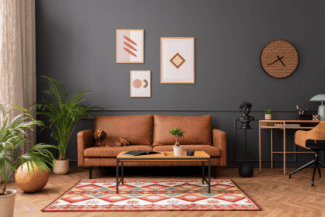A Model Apartment Can Turn a Lookie-Loo into a Tenant
Have you ever shown your cold, vacant, unfurnished rental unit to a prospective tenant who immediately said,” “I want to live here”? Not often, I would bet. But show that same applicant the same floorplan all done up as a warm, welcoming model apartment and the response will be quite different.
A common sign that a lookie-loo has turned into a tenant is when they sit down in the model and make themselves at home. They can’t do that if there isn’t any furniture to sit on.

Apartment staging is an opportunity to market your property, show off your open units in the best way possible and convert more prospects into residents. You’ll also want to pay attention to what the renters see when they first step in the front door. That first impression, whether it be a bare, unstaged home or a welcoming, perfectly staged one, can make the difference in whether they decide to rent and how much they are willing to pay to live there.
Staging is the process of decorating a living space with the specific intention of making it look like an appealing place to live. By learning the basics of home staging, you can create an appealing model apartment, thereby increasing the odds that prospective tenants will want to make it their home.
According to the National Association of Realtors, staging decreases the time an apartment spends on the market and increases the price a resident is willing to pay by 10-15%. The extra profit often outweighs the cost of staging, which makes it worthwhile in most cases.
An added plus of staging is that you might be able to deduct the cost as an advertising expense if the unit is rented. Please consult with your tax preparer for details.
Choosing the Right Stager
Choosing the right stager for your property can take a little time, but it is worth the effort. You want to hire the professional stager who understands your property and your goals. Obtain quotes from at least three staging companies familiar with your area and get a detailed written contract that outlines the services included in the fee.
Ask the professional home stager the following questions to ensure that you hire the best firm for the job:
- How long have you been staging homes?
- Do you have experience staging homes in my local market?
- Can you provide references and photos of your previous work?
- Can you walk me through your home staging process?
- Do you offer an initial consultation? If so, how much does it cost?
- What services does your staging fee include?
- What add-on services do you offer for an extra fee?
- Do you offer partial staging for specific rooms?
- Do you provide furniture and décor, or will I need to rent those items separately?
- Can you work with my existing furniture and décor, or do I need to remove everything from the apartment?
It is helpful to work with your stager to create a profile of your typical renter as a guide for styling your vacant apartment or model. A common strategy for stagers is to imagine a typical tenant and decorate the unit as if they were living there.
If a home stager can help prospective tenants envision how fabulous your living room looks with a little tasteful furniture and attractive decor, the costs of home staging may be some of the best money you have ever spent.
Free Rental Application
Get 20 Rental Forms for FREE, including a rental application.
Staging an apartment or single-family house for rent may include:
- Decorating your property’s exteriors for curb appeal
- Arranging furniture in each room
- Creating homey vignettes that suggest a romanticized version of home
- Removing odors left by the last tenant, such as from smoke or pets
- Hanging curtains or installing new blinds
- Upgrading appliances to newer models
Home stagers can also upgrade light fixtures and paint rooms to make them appealing to the largest number of prospective tenants.
How to save money on staging
Follow these tips to save money on home staging while still increasing the chance your rental will be leased sooner and for a higher price:
- Stage only the most important rooms instead of the whole house or apartment. According to the National Association of REALTORS®, staging the living room has the most impact on buyers, followed by staging the primary bedroom and kitchen.
- Use your own furniture and décor instead of renting.
- Limit the furniture rental cost by renting only a few key pieces of furniture.
- Hire a home stager for a consultation, then apply the stager’s recommendations yourself.
Whether you can do it yourself or hire a professional, the best staging should be done before an apartment is photographed and listed online.
Having a staged model not only allows your prospective tenants to imagine themselves living in your rental, it will enhance your listings, advertisements and social media. It makes it easier for potential renters to visualize a warm, inviting space as their future home.















 Accessibility
Accessibility